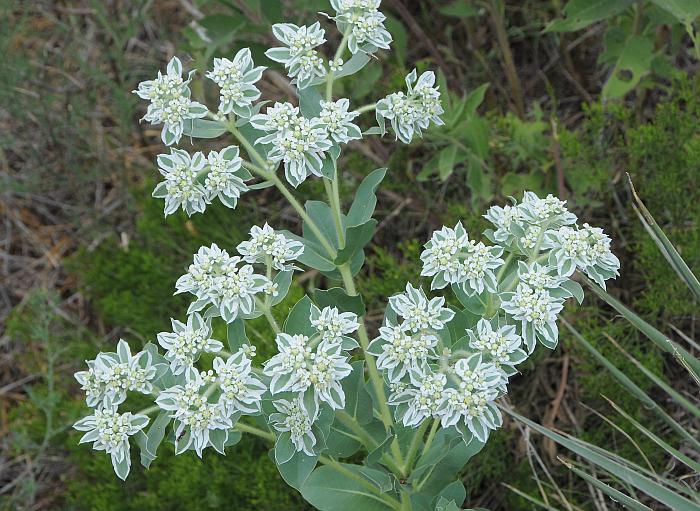Euphorbia marginata Pursh
Snow-On-The-Mountain

Native
CC = 3
CW = 5
MOC = 22
© SRTurner
Euphorbia marginata PurshSnow-On-The-Mountain | |
 |
Native CC = 3 CW = 5 MOC = 22 |
© SRTurner |
|
Family - Euphorbiaceae Stems - To about 1 m, ascending to erect, usually unbranched below inflorescence, pubescent with spreading or tangled hairs, especially toward tips, often glabrous toward base. Latex milky.
Leaves - Alternate below inflorescence branches, sessile or short-petiolate, simple, broadly ovate, usually sharply pointed, entire or slightly undulate along margins, glabrous or sparsely pubescent. Leaves in inflorescence branches opposite or whorled, narrower than lower leaves. Uppermost leaves with conspicuous broad white margins.
Inflorescence - Terminal umbellate panicles, multiply branched, with whorl of leaves at base. Cyathia solitary or in small clusters at the branch tips, solitary at the branch points.
Cyathia - Involucre 3-4 mm long, surfaces sparsely to densely hairy, the rim 5-lobed, the lobes deeply divided into a fringe of slender, pale lobes, the marginal glands 5, 1.0-1.8 mm long, oblongelliptic to nearly circular and often somewhat concave, green to light green or yellowish green, with a relatively conspicuous petaloid appendage 2-4 mm long, this white. Staminate flowers 35-60 per cyathium. Ovaries densely pubescent, 3-locular, the styles 1.0-2.5 mm long, each divided 2/3-3/4 of the way from the tip into 2 relatively slender lobes.
Fruits - Fruits 4-6 mm long, 3-locular, hairy. Seeds 3-4 mm long, nearly circular in outline and cross-section, rounded at the base, the surface with a network of irregular wrinkles or blunt ridges and sometimes also low, rounded tubercles, orangish tan to olive gray, sometimes with a thin, white coating.
Flowering - June - October. Habitat - Prairies, pastures, gardens, roadsides. Origin - Native to the U.S. Other info. - This showy and distinctive species is not particularly common in Missouri, except in the far western reaches of the state. It becomes quite common immediately to our west, with Kanas representing the approximate center of the plant's natural range. It is often cultivated in gardens for its attractive appearance, and sporadically escapes cultivation. Steyermark noted that it grows well in hot, dry, clay soils. The milky sap of this plant, like all spurges, contains compounds which are mildly toxic as well as irritating to skin and mucous membranes. Photographs taken at Tallgrass Prairie National Peserve, Chase County, KS, 9-1-2012; at Shaw Nature Reserve, Franklin County, MO, 9-8-2012; and along Hwy 24 near Sheridan State Fishing Lake, Sheridan County, KS, 7-28-2017 (SRTurner); also in St. Louis, 9-10-2020 (KBildner). |